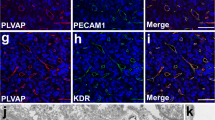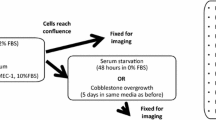Summary
Five different types of cultured microvessel endothelial cells defined by use of light microscopy and scanning electron microscopy in a preceding study were investigated by transmission electron microscopy. Type-1 cells displayed a deep invagination of the cell membrane or a single cilium. Granules of low electron density were abundant. A perinuclear ring of intermediate filaments occurred. Cultures of type-2 cells were subdivided into phenotype A, reminiscent of cell-type 1, and into phenotype B, assumed to be vascular smooth muscle cells. Many highly electron-dense granules appeared in late postconfluent cultures of both phenotypes. Cell-type 3 was conspicuous because of a large intracytoplasmic vacuole. Lysosomes with curvilinear bodies were found in cell-types 3 and 4. Both cell types developed a peripheral regular network of microfilaments. Cell-type 5 showed vesiculation of the rough endoplasmic reticulum, lipid droplets and a peripheral felt-like belt of microfilaments. Tubular forms seen in late postconfluent cultures of cell-types 1 to 3 displayed a core of extracellular matrix. Pseudotubular forms of cell-type 4 contained apoptotic bodies. Thus, as seen at the ultrastructural level, different features are maintained by cultured microvessel endothelial cells, suggesting that they have different inherent properties.
Similar content being viewed by others
References
Beertsen W, Everts V, Houtkooper JM (1975) Frequency of occurrence and position of cilia in fibroblasts of the periodontal ligament of the mouse incisor. Cell Tissue Res 163:415–431
Blose SH (1984) The endothelial cytoskeleton. In: Jaffe EA (ed) Biology of the endothelial cells. Martinus Nijhoff, Boston, pp 141–154
Blose SH, Chacko S (1976) Rings of intermediate (110 Å) filament bundles in the perinuclear region of vascular endothelial cells. J Cell Biol 70:459–466
Bundgaard M, Frokjaer-Jensen J, Crone C (1979) Endothelial plasmalemmal vesicles as elements in a system of branching invaginations from the cell surface. Proc Natl Acad Sci USA 76:6439–6442
Chamley JH, Campbell GR, McConnell JD (1977) Comparison of vascular smooth muscle cells from adult human, monkey and rabbit in primary culture and in subculture. Cell Tissue Res 177:503–522
Chamley-Campbell J, Campbell GR, Ross R (1979) The smooth muscle cell in culture. Physiol Rev 59:1–61
Fawcett DW (1986) Bloom and Fawcett — a textbook of histology, 11th edn. WB Saunders, Philadelphia London, pp 384–390
Feder J, Marasa JC, Olander JV (1983) The formation of capillary-like tubes by calf aortic endothelial cells grown in vitro. J Cell Physiol 116:1–6
Folkman J, Haudenschild C (1980) Angiogenesis in vitro. Nature 288:551–556
Fowler S, Shio H, Wolinsky H (1977) Subcellular fractionation and morphology of calf aortic smooth muscle cells. J Cell Biol 75:166–184
Ghadially FN (1988) Ultrastructural pathology of the cell and the matrix, vols 1 and 2, 3rd edn. Butterworths, London Boston
Gimbrone MA, Cotran RS (1975) Human vascular smooth muscle in culture. Lab Invest 33:16–27
Gospodarowicz D, Brown KD, Birdwell CR, Zetter BR (1978) Control of proliferation of human vascular endothelial cells. J Cell Biol 77:774–788
Grant DS, Tashiro K-I, Segui-Real B, Yamada Y, Martin GR, Kleinman HK (1989) Two different laminin domains mediate the differentiation of human endothelial cells into capillary-like structures in vitro. Cell 58:933–943
Greenburg G, Vlodavsky I, Foidart JM, Gospodarowicz D (1980) Conditioned medium from endothelial cell cultures can restore the normal phenotypic expression of vascular endothelium maintained in vitro in the absence of fibroblast growth factor. J Cell Physiol 103:333–347
Grim M, Mrázková O, Carlson BM (1986) Enzymatic differentiation of arterial and venous segments of the capillary bed during the development of free muscle grafts in the rat. Am J Anat 177:149–159
Haudenschild CC, Cotran RS, Gimbrone MA Jr, Folkman J (1975) Fine structure of vascular endothelium in culture. J Ultrastruct Res 50:22–32
Höckel M, Sasse J, Wissler JH (1987) Purified monocyte derived angiogenic substance (angiotropin) stimulates migration, phenotype changes and “tube formation” but not proliferation of capillary endothelial cells in vitro. J Cell Physiol 133:1–13
Jaffe EA, Nachman RL, Becker CG, Minick CR (1973) Culture of human endothelial cells derived from umbilical veins. J Clin Invest 52:2745–2756
Kubota Y, Kleinman HK, Martin GR, Lawley TL (1988) Role of laminin and basement membrane in the morphological differentiation of human endothelial cells into capillary-like structures. J Cell Biol 107:1589–1598
Lipton BH (1977) A fine-structural analysis of normal and modulated cells in myogenic cultures. Dev Biol 60:26–47
Maciag I, Wilkins KL, Stemerman MB, Weinstein R (1982) Organizational behavior of human umbilical vein endothelial cells. J Cell Biol 94:511–520
Madri JA, Williams SK (1983) Capillary endothelial cell cultures: phenotypic modulation by matrix components. J Cell Biol 97:153–165
Madri JA, Pratt BM, Yannariello-Brown J (1988) Matrix-driven cell size change modulates aortic endothelial cell proliferation and sheet migration. Am J Pathol 132:18–27
McAuslan BR, Hannan GN, Reilly W (1982) Signals causing change in morphological phenotype, growth mode, and gene expression of vascular endothelial cells. J Cell Physiol 112:96–106
Price ZH (1967) The micromorphology of zeiotic blebs in cultured human epithelial (HEp) cells. Exp Cell Res 48:82–92
Remy L (1986) The intracellular lumen: origin, role and implications of a cytoplasmic neostructure. Biol Cell 56:97–106
Rhodin JAG (1967) The ultrastructure of mammalian arterioles and precapillary sphincters. J Ultrastruct Res 18:181–223
Rhodin JAG (1968) Ultrastructure of mammalian venous capillaries, venules, and small collecting veins. J Ultrastruct Res 25:452–500
Ross R (1971) The smooth muscle cell. II. Growth of smooth muscle in culture and formation of elastic fibers. J Cell Biol 50:172–186
Schor AM, Schor SL, Allen TD (1983) Effects of culture conditions on the proliferation, morphology and migration of bovine aortic endothelial cells. J Cell Sci 62:267–285
Sherer GK, Fitzharris TP, Faulk WP, LeRoy EC (1980) Cultivation of microvascular endothelial cells from human preputial skin. In Vitro 16:675–684
Simionescu M, Simionescu N, Palade GE (1975) Segmental differentiations of cell junctions in the vascular endothelium. The microvasculature. J Cell Biol 67:863–885
Simionescu M, Simionescu N, Palade GE (1976) Segmental differentiations of cell junctions in the vascular endothelium. Arteries and veins. J Cell Biol 68:705–723
Spanel-Borowski K, Bosch J van der (1990) Different phenotypes of cultured microvessel endothelial cells obtained from bovine corpus luteum. Study by light microscopy and by scanning electron microscopy (SEM). Cell Tissue Res 261:35–47
Trauth BC, Klas C, Peters AMJ, Matzku S, Möller P, Falk W, Debatin K-M, Krammer PH (1989) Monoclonal antibody-mediated tumor regression by induction of apoptosis. Science 245:301–305
Wyllie AH, Kerr JFR, Currie AR (1980) Cell death: the significance of apoptosis. Int Rev Cytol 68:251–306
Author information
Authors and Affiliations
Rights and permissions
About this article
Cite this article
Spanel-Borowski, K. Diversity of ultrastructure in different phenotypes of cultured microvessel endothelial cells isolated from bovine corpus luteum. Cell Tissue Res. 266, 37–49 (1991). https://doi.org/10.1007/BF00678709
Accepted:
Issue Date:
DOI: https://doi.org/10.1007/BF00678709




